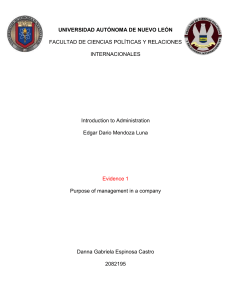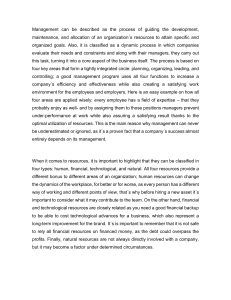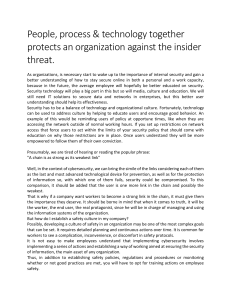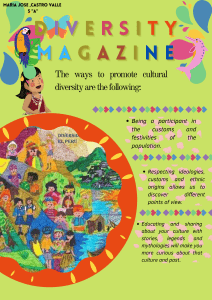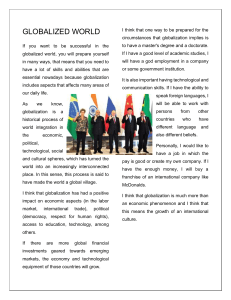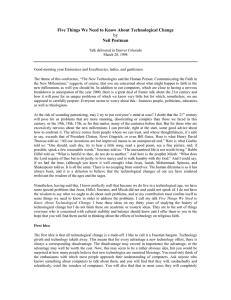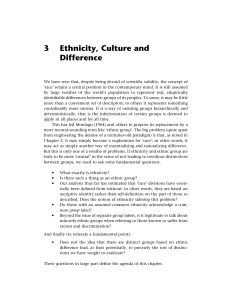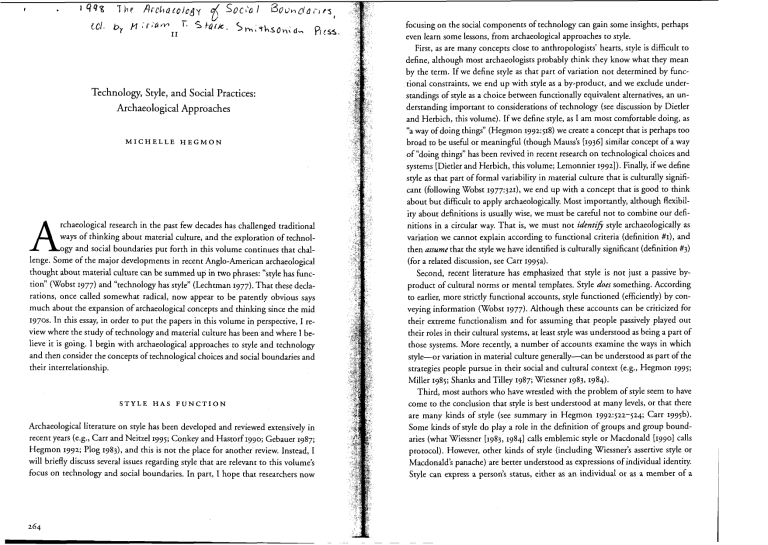
Technology, Style, and Social Practices: Archaeological Approaches MICHELLE HEGMON A rchaeological research in the past few decades has challenged traditional ways of thinking about material culture, and the exploration of technology and social boundaries put forth in this volume continues that challenge. Some of the major developments in recent Anglo-American archaeological thought about material culture can be summed up in two phrases: "style has function" (Wobst 1977) and "technology has style" (Lechtman 1977).That these declarations, once called somewhat radical, now appear to be patently obvious says much about the expansion of archaeological concepts and thinking since the mid 1970s. In chis essay, in order to put the papers in this volume in perspective, I review where the study of technology and material culture has been and where I believe it is going. I begin with archaeological approaches to style and technology and then consider the concepts of technological choices and social boundaries and their interrelationship. STYLE HAS F U N C T I O N Archaeological literature on style has been developed and reviewed extensively in recent years (e.g., Carr and Neitzel1995; Conkey and Hastorf 1990; Gebauer 1987; Hegmon 1992; Plog 1983), and this is not the place for another review. Instead, I will briefly discuss several issues regarding style that are relevant to this volume's focus on technology and social boundaries. In part, I hope that researchers now focusing on the social components of technology can gain some insights, perhaps even learn some lessons, from archaeological approaches to style. First, as are many concepts close to anthropologists' hearts, style is difficult to define, although most archaeologists probably think they know what they mean by the term. Ifwe define style as that part of variation not determined by functional constraints, we end up with style as a by-product, and we exclude understandings of style as a choice between functionally equivalent alternatives, an understanding important to considerations of technology (see discussion by Dietler and Herbich, this volume). If we define style, as I am most comfortable doing, as "a way of doing things" (Hegmon 1992:518) we create a concept that is perhaps too broad to be useful or meaningful (though Mauss's [1936] similar concept of a way of "doing things" has been revived in recent research on technological choices and systems [Dietler and Herbich, this volume; Lemonnier 19921). Finally, ifwe define style as that part of formal variability in material culture that is culturally significant (following Wobst 1977:321), we end up with a concept that is good to think about but difficult to apply archaeologically. Most importantly, although flexibility about definitions is usually wise, we must be careful not to combine our definitions in a circular way. That is, we must not identijj style archaeologically as variation we cannot explain according to functional criteria (definition #I), and then assume that the style we have identified is culturally significant (definition #3) (for a related discussion, see Carr 1995a). Second, recent literature has emphasized that style is not just a passive byproduct of cultural norms or mental templates. Style does something. According to earlier, more strictly functional accounts, style functioned (efficiently) by conveying information (Wobst 1977). Although these accounts can be criticized for their extreme functionalism and for assuming that people passively played out their roles in their cultural systems, at least style was understood as being a part of those systems. More recently, a number of accounts examine the ways in which s t y l e o r variation in material culture generally--can be understood as part of the strategies people pursue in their social and cultural context (e.g., Hegmon 1995; Miller 1985; Shanks and Tilley 1987; Wiessner 1983,1984). Third, most authors who have wrestled with the problem of style seem to have come to the conclusion that style is best understood at many levels, or that there are many kinds of style (see summary in Hegmon 1992:522-524; Carr 1995b). Some kinds of style do play a role in the definition of groups and group boundaries (what Wiessner [1983, 19841 calls emblemic style or Macdonald [1990] calls protocol). However, other kinds of style (including Wiessner's assertive style or Macdonald's panache) are better understood as expressions of individual identity. Style can express a person's status, either as an individual or as a member of a t group. And sometimes style seems to have little to do with social distinctions and instead is best understood as an expression of cultural understandings of the universe (see David et al. 1988; also Franklin's [1986] concept of stochastic style). Finally, the study of style often forces archaeologists to wrestle with complex social concepts. At least since Childe's (1951) SocialEvolution, we have been warned that archaeological "cultures" (often defined in terms of styles) are not necessarily equivalent to ethnic groups or any kind of human grouping (see review in Shennan 1989). As MacEachern (this volume) notes, archaeology may not be wellsuited to do ethnography of the past. We can work towards understanding the societies of the past, but pcrhaps not in the same way that societies of the present can be understood. Specifically, many ethnographic concepts-such as society or kinship-refer to kinds of interactions and beliefs, not entities or things. If we use those concepts in our investigations of the past, we must guard against reiGing the concepts and looking for "things" that do not really exist (see discussion in Eriksen 199~127-128). For example, the "ceramic sociology" studies of rhe 1960s and early 1970s (e.g., Hill 1970; Longacre 1970) were innovative, optimistic, and (to me) inspirational studies that attempted to develop methods by which archaeologists could learn about the details of past social organization, particularly kinship systems. Because of their importance, these studies have been scrutinized from every angle and often criticized (for reviews of this literature, see Hegmon 1992; Plog 1978). Most of the criticisms have to do with methodology (temporal control, design classification, etc.), but the theoretical problems are more relevant here. That is, at the same time that archaeologists were attempting t ~ j n d ~ r e h i s t o rkinship ic systems, social anthropologists were questioning the existence of kinship as a socialfact, and asking how professed kinship principles actually relate to kjnship practice (see, for example, Barnes 1962; Goodenough 1956; Kelly 1976; Stanislawski and Stanislawski 1978). The problem is that the kinship systems had been reified and turned into things, rather than being understood as potentially problematic concepts in the dynamics of social relations. T E C H N O L O G Y HAS STYLE Archaeologists' broadening understanding of style was paralleled by a broadening understanding of technology, ushered in by the series of papers in Lechtman and Merrill (1977). No longer was technology viewed only as a means to an end, a form of material adaptation. Rather, Lechtman (1977) made it clear that technology had a style of its own, and that technology could only be understood within its social and cultural context. Here I review several approaches that relate tech- nology and society and that are fairly closely tied to the issue at hand, that is technology and social boundaries. My focus necessarily, but unfortunately, excludes work on other aspects of technology and society including the growing literature on the sociality of tool use (Ingold 1993b); Marxist perspectives on the mode of production (e.g., Bender 1978; Hindess and Hirst 1975; Ingold 1986); a long history of research on the organization of production and specialization (Costin 1991; Rice 1981); perspectives on how the value and meaning of goods are social products ( Appadurai 1986b; Douglas and Isherwood 1979); and recent work on the multiple factors involved in technological organization (Nelson 1991). In a series of papers, James Sackett put forth a perspective on material culture variation critical to the understanding of technology and boundaries (this perspective is reviewed and summarized in Sackett [I9901 and it is most extensively developed in Sackett [1982]). Sackert described what he called isochrestic variation, isochrestic meaning "equivalent in use." When there are several functionally equivalent ways to make or do something, people choose between those ways based in large part on their cultural traditions. Those choices arc isochrestic choices, and the resulting patterning is what Sackett calls isochrestic variation. Although isochrestic variation is sometimes described as a kind of style, this is not Sackett's meaning. Instead, he argues that style is a subset of isochrestic variation, specifically, the part of isochrestic variation that has ethnic significance, whether or not it is actively used to signal ethnicity. In a sense, Sackett is arguing that technological choiccs, as wcll as decoration, can have style and can provide archaeologists with information about social boundaries. In 1977 Heather Lechtman articulated the idea that technology has style, drawing from her work on Andean technologies, particularly metallurgy. She argued that Andean metallurgy cannot be understood in terms of Old World utilitarian models, which emphasize properties such as strength and hardness. Instead, Andean metallurgy, which focuses on soft metals such as gold and silver and seems to put great emphasis on the color of final products, can only be understood in terms of the Andean symbolic system and conception of the universe. That is, Andean smiths achieved gold and silver colors not by gilding (i.e., applying a thin coat of the precious metals to the surface of objects) but by complex techniques of enriching the metals on the surface of alloys (gold and copper or silver and copper). Thus, gold and silver were intrinsic and essential parts of the alloy mixtures and the object themselves, they were not just surface coverings. Similarly, Andean textile production also emphasized the incorporation of designs into the structure of the cloth. Lechtman argues "that key technologies associated with cloth and metal production shared stylistic modes, ~ e r h a p because s those modes are expressions of cultural ideals, incorporating ideological concerns of the society at large" (Lechtman r993:273). I t ~echthan'sconcept of technological style involves normative cultural behavior and the rules behind that behavior (1977:1z). However, Lechtman's concept of technological style is quite different from Sacketti concept of sometimes passive isochrestic variation. Technological style actively involves symbolic structures as ' I I ' well as attitudes of the community and artisans. Furthermore, technological style does more than simply express ideology; the technology (and artisans who make it) play a role in perpetuating and possibly changing status relations and basic ideological concepts (Dobres and Hoffman [1994:~17-219]develop this perspective on Lechtman's work). In general, Lechtman opened avenues of exploration for archaeologists by demonstrating that at least some aspects of prehistoric technology could best be understood from an ideational perspective, and she laid the groundwork for exploring the social role of technology. Pierre Lernonnier (1986,1989,1992) has also developed an understanding of the 1 1 1 relationship between technology and society, drawing from his ethnographic studies of the technical systems of the Anga in Papua New Guinea. He conceives of technological activity as the interplay between matter, energy, objects, gestures in sequence, and knowledge. Lemonnier places much emphasis on the operational sequences of technology, not just the final product. He argues that those ogerational sequences involve technological choices. Furthermore, those choices-ineluding some, such as sequences of gestures, that have no obvious effect on the fi- , i 1 I : nal material product-are the product of social learning processes and may be social actions, sometimes used to mark group distinctions. 1 Like Lechtman, Lemonnier is interested in technological styles and in relating those styles to a society's world view (see Dobres and Hoffman I ~ ~ ~ : Z I ~ - Zfor Z Ia comparison of the two). However, the two researchers emphvize different aspects of the relationship of technology and society. Specifically,although Lechtman considers how technology is used to mark status distinctions, much of her emphasis is on how ideology and world view shaped Andean technologies Furthermore, although much of her research focused on understanding how Andean metals were produced, her explanation of metallurgical practices emphasizes the properties of the final product, that is. the fact that gold and silver are part of the essence of alloy metals. In contrast, although Lemonnier considers the relationship between technology and Anga conceptions of the universe, his emphasis is on the dynamic interplay between technology-particularly operational sequences-and social groups. Some of the differences between Lechtmani and Lemonnieri approaches may be theoretical, and other differences may result from archaeological vs. ethnographic research. In addition, the researchers' understandings may be a factor of intrinsic differences in the kinds of technologies they studied. That is, the production of ~reciousmetals by specialists in a stratified society may be much more stable and less open to social manipulation than the production of everyday items in a tribal society. These kinds of differences may provide a useful avenue of exploration for anthropologists interested in the relationship between society and technology. In a recent statement, Dobres and Hoffman (1994) attempt to advance anthropologists' understanding of social agency in prehistoric technology They argue that "the final goal of technological studies is not to describe microscale prehistoric activities, but to understand microscale social processes" (Dobres and Hoffman 1994:2I?, emphasis in original). They argue that practice theoly (see Ortner 1984), including Giddens's (1984) concept of structuration and Bourdieui (1977) concept of habitu~,can be used by archaeologists to understand the dynamic interplay between technology and society. Specifically,both the operational sequences and the products of technology are part of a society's structure a n d o r habitus. At the same time, people are part of those operational sequences, and ~ e o p l eproduce things. Thus people-active social agents-participate in the reproduction and change of their society (see also Dietler and Herbich, this volume; Moore 1986). lngold (~gqja,19gib) makes an important distinction between technique and technology, a distinction relevant to an understanding of agency and technology To Ingold, technique involves "the embodied skills of human a g e n t i while technology comprises "the operational principles embodied in rhe external apparatus of production" (Ingold 199)a:342). In a sense, technique is to technology as agency is to structure; an understanding of either depends on a consideration of the relationship. If we focus too srmngly on technology, as he defines it, we risk objectifying or reifying it, turning it into an object separate from human agency. Furthermore, Ingold suggests that a focus on objective, aplicit technology in contrast t Western society's increasto more subjective experiential technique is a ~ r o d u cof ing dependence on mechanical systems. If he is correct, then archaeologists' emphasis on systems of technology may involve an imposition of our own social constructs on the past and may cause us to underestimate the importance of human agency in the form of individud skills and techniques, at least rhis would be the interpretation from the perspective of critical theory The result of rhis emphasis on technology and systems "is tantamount to a dinmbedding of technical relations from their matrix in human sociality, leading to the modern opposition between technology and society" (Ingold 1993b:436).' I find the concepts of agency and structuration. or practice and habitus to be helpU in my own thinking about what sociev is and how material culture can be understood as part of complex social dynmicr (Hegmon 1991). However, 1 believe that we must guard against simply adopting these new (stylish) words and applying them to old concepts. That is, habirw is not the same thing as culture, and agency cannot be equated with the behavior of an individual in an o~timality model. Practice theory demands that we consider what Giddens (1991) calls the ' dualiry'(the dynamic interplay) of structure and agency or habitus and practice. Furthermore, we may benefit by drawing what is best or most useful from different approaches For example, Bourdieui (especially 1977, 1990) is probably most UYLIfor understanding practice or human agency and how it is directed by hnbitus in contrast, Giddens (especially 1984) is probably more useful in helping us understand how agency affects the structure and social change at a larger scale, the process he calls structuration. Other important perspectives on the interphy-or dialectic-of structure and agency are developed in historical Manist accounts (e.g., Callinicos 1988;Thompson ~gpr),and in Archer's (1988) work on culture and agency. While the link between such complex social theory and archaeological data is not obvious or direct, neither is the link between social boundaries and material culture. Bwe, as archaeologists, wish to understand the rehtionrhip bemeen a social process and material culture, we must be prepared to understand the complexity of that social process, and in this endeavor we will be well served by current social theory including practice theory. Archaeologists have begun to apply this theory to gain new insights about past social dynamics (e.g.. Clark and Blake 1994). Bourdieui concept of hnbihs, which was developed as part of his study of Berber architecture, holds particular promise for research on material culture (see Hodder 1992:73-77). Unfortunately, many archaeologists are still waiting to see practice theory concepts fully used in the interpretation of prehistoric material culture. Although Dobres and Hoffman (1994) cite a number of excellent studies I that provide information regarding technology and society (see also Dobres 1 9 ~ 9 , they provide only one example that explicitly uses the concept of human agency Unfortunately, that study (M. Johnson 1993) concerns historic English housing. Ironically, the author of that study has previously criticized archaeologists for Failing to put the concept of agency into practice (M. Johnson 1989). Dietler and Herbich (this volume) also provide a thorough discussion of habias and technological choices, though their examples are ethn~archaeolo~ical, not prehistoric. ' I ' ' A growing literature on sociotechnical systems (mostly outside of anthropology) may be extremely useful to archaeologists interested in the relationship between I technology and society. Much of this work is summarized by Pfaffenberger (1992). 1 A sociotechnical system is more than the procedures used to achieve some technical end; the concept draws in the ideology and the social relations involved and it grants agency to the people involved. One example of such a sociotechnical system is the water control system in Bali, which involves water temples and priests as well as irrigation procedures (PfafFenberger 1992:yog-jro) Sociotechnical systems are not necessarily perfectly efficient in a utilitarian sense; in fact, they cannot be understood without accounting for the material symbols that they involve. I Sociotechnical systems "produce power and meaning as well as goods" (Pfaffen- I I I berger 1992:502). The concept of sociotechnical systems may be useful to researchers interested in the concept of practice. Specifically, the creation of a sociotcchnical system involves structuration in that social actors work within the system but also can work to change the system (PfafFenberger 1992:5oo). SOCIAL BOUNDARIES: T H E CONCEPT At least two g e n e d approaches to the archaeology of social boundaries are represented by the authors of this collection of papers. First, the overall thrust of the volume, as expressed by the editor, is on discovering how technologicd choices reJrit social boundaries (Stark, this volume). This approach takes the existence of social boundaries as unproblematic. It is assumed that boundaries (like the kinship systems studied by the ceramic sociologists) were social facts of the p a t . Emphasis here is on developing detailed methods that will allow us to identib those social facts. The chapter by Dietler and Herbich generally fits with this first approach but expands it in important ways. That is, rather than assuming a relationship between social boundaries and technology, Dietler and Herbich explore that relationship theoretically and help us understand why and how it exists in certain cases. A second approach represented in this volume attempts more directly to wrestle with the very concept of social boundaries. This perspective is rob ably best articulated by Goodby (this volume, p. 161) when he says "social boundaries are abstractions and ideological constructs, recognized differently and for different reasons by people on the basis of their ~erceivedidentity, interests, and social context" (see also MacEachern's introduction, and Hitchcock and Bartram's musing about fences). The point here is that if atchaeologists mean to study social boundaries in the past, we need to wrestle with the concept, with what social boundaries are and might have been. Here social theory, in all its complexiry, must lay a role. Some perspective on these contrasting approaches can be g ~ n e dfrom the literature on ethniciq which is closely related to the concept of social boundaries. As MacEachern (this volume) notes, archaeologists are fond of citing Barth's (1969a) Ethnic Groups and BounLrirr At least two major arguments directly relevant to archaeology are developed in that volume. First, Barth, and others in the volume, emphasize structure over content. That is, they are more concerned with a boundary as an expression of some sort of difference than with the s ~ e c i f i aof what lay on either side of that boundary. This strikes an optimistic note for archaeologists, who are more likely to be able to discover the existence of boundaries than to understand the specific content of bounded units. Second, the volume solidified anthropologists' and other social theorists' un- demanding of ethnic groups and boundaries as social constructs, not social facts. "Ethnic groups are categories of ascrzption and identification by . . . actors themselves, and thus have the characteristic of organizing interaction b e w n people" (Barrh 1969a:10, emphasis in original). Barth emphasized that there is no one-toone correspondence between ethnic units and cultural similarities. "The features that are taken into account (in marking ethnic boundaries) are not the sum of 'objective' differences, but only those which the acton themselves regard as significant" (Barth 1969a:rq).And while the literature on ethnicity is vast and somewhat contentious, there does seem to be a consensus regarding this conclusion; that is, ethnicity involves ie~consciouridentification (e.g., Bentley 1987; Edlcren 1991; Kumar and Kadirgamar 1989:vii; Moerman 1965). In other words, ethniciry does not simply exist; it is something that people do. Eriksen (1991:127-128) provides a Summary of the problem of reifying ethnic groups as fixed entities, and Schortman (1989) ~rovidesa discussion of the way in which named concepts influence research. Perhaps somewhat ironically, Barth's later work, rarely cited by archaeologists, has emphasized this aspect of how people create their own cultural and social realities (e.g., Cosmologies in the Making 1787). This understanding of ethniciry as "something that people do" is potentially problematic for archaeologists interested in the study of boundaries. Clnrly such an understanding adds to the complexity of our studF It also supports the questioning of what boundaries are, part of the second group of studies (those by Goodby, MacEachern, and Hitchcock and Bartram), and is relevant to approaches concerned with human agency (e.g., Dietler and Herbich, this volume; Dobres and Hoffman 1994). O n the one hand, we archaeologists cannot simply do ethnography in the past. At the same time, a perspective that questions what boundaries are also opens new possibilities for research. If we can identify under what conditions certain kinds of material-induding technologicaldifferences exist and how those differences change over time and space, we might be able to add a new perspective to the study of social boundaries (Buchignani 1987). Furthermore, archaeology should be able to provide a historical perspective, something Barth's work has been criticized for lacking (e.g., Wolf 1982). Research on ethnicity has long involved debates between contrasting sets of ideas. T h e content vs. structure dichotomy, discussed above with regard to Barthi work, has also taken form as a debate between primordial and instrumental theories. Primordialists generally argue that ethnic differences arise as a result of differences in language and appearance. In contrast, instrumentalists argue that groups create their ethnic identities for instrumental (i.e., politid and economic) reaons. For summaries of some of these debates see Barth (1969a), Bentley (1987), Eriksen (1991), and A. S. Brooks et al. (1993). Recent work on ethnicity has attempted to resolve some of these debates by ac- cepting at least some parts of "all of the above." That is, according to Eriksen (1991), in an article entitled "The Cultural Contexts of Ethnic Differences," we must take into account both the formal structures and the content within those structures; furthermore, we must understand the interrelationship between the content and structure. This kind of solution has also been expressed in terms of Specifpractice theory (Bentley 1987; see also Geary 1983;Worsley 1984:2~2-2~~). ically, ethnicity can be understood in terms of the interaction (or dialectic) between, on the one hand, existing (but not immutable) structures or ethnic groups, and, on the other hand, the strategies of actors in a given social context. To put it in other terms, habitus, which molds-often at a subconscious level-what people are, contributes to the creation of apparent ethnic differences (the primordialist view). Ethnic symbols are open to manipulation (the instrumentalist view), though they did not come into being simply for manipulative purposes. Finally, changed by the actions of those people. the habitu~is reproduced and whether or not ethnicity is purposely altered. This kind of dynamic approach to ethnicity may be useful for archaeologists interested in practice t h e o v A final point I wish to raise regarding ethniciry is that many scholars have argued that it is essentially a product of state-level societies (Smith 1986) or even of industrialism, market forces, and colonialism (Gellner 1983; Pryor 1989; see summary in Shennan 1989:11-17). This argument is not unlike Fried's (1968) questioning of the concept of the tribe. If these authors are correct, the concept of ethnicity may be irrelevant for most archaeologists studying pre-state societies (see Suttles 1987). At the same time, archaeologists studying very complex societies andlor colonialism may be positioned to ~rovidea unique and important perspective on the origin of ethnicity (Brumfiel 1994; Goodby this volume; McLaughlin 1987). T h e point is not that most archaeologists should simply avoid the word "ethnicity," but rather, we should be wary of the concept it invokes, especially in research on pre-state societies. That is, ethniciry connotes a l ~ - e ~ c o m ~ a s smarked rin~ and bounded groups, and it may be that such clear-cut groups did not exist in much of the part. At the very lest, if we wish to assume that such bounded groups did exist, we need to justify our assumption. A reh historic material culture boundary may be indicative of some kind of social boundary, but such a material boundary should not automatically be equated with an ethnic boundary without further information on social processes. For example, the concept of ethnicity involves int,rgenerational self-identity that is sustained, and even e m ~ h a s i u din , contact with other ethnic groups. Thus one ~ossiblearchaeological correlate of ethnicity might be that it persists intergenerationally, as it clearly does in protohistorichistoric New England (Goodby, this volume). In contrast, in the American Southwest, there are several well-documented examples of groups migrating into new ' areas and bringing a distinct material culture tradition with them (e.g., Adams and Hays 1991: Haury 1958; Stark, Clark, and Elson 1995). However, it is not possible to evaluate whether the material culture differences persisted intergenentionally, because the migrants apparently lefi the area afier a decade or so or the occupation as a whole ended.= In arguing that not all archaeologists can study ethnicity, I do not intend to limit the archaeological enterprise. Instead, I suggest that archaeologists may be particularly well positioned ro consider social forms no longer prevalent in today's world. That is, social groups certainly did exist in the past, but they may have had structures that were different from and more florible than those of ethnic groups (see also MacEachern, Welsh and Terrell, and Sta& et al., this volume). It is likely that people have always defined themselves in terms of material culture differences (including technology) and that part of that definition involved group identity (Wiessner 1 ~ 8 4.) However, rather than being a member of a bounded group, people may also have had networks of overlapping identities. Again, I urge archaeologists to question the concept of boundaries and to consider other kinds of social relationships. THE RECOGNITION OF BOUNDARIES Despite what I have just said. social boundaries appear to exist in the world today, even if many of these boundaries were created o; reified by state societies and colanial administrations. What can we learn from these? Do the social boundaries have any relationship to technological choices or to other aspects ofmaterial culture? Unfortunately, the answer, almost universally, is "~ometimes.~ The point is not to present a cautionary tale, but to explore at which times certain kinds of boundaries have expression in certain kinds of material or technology In the following discussion, although I emphasize insights gained by studies of technology. I also draw from studies of style. This is because I do not wish to assume, a priori, that either style or technology is better suited for the study of social boundaries. First, a number of studies have found that various technological differences do seem to correspond to social differences or ethnic boundaries. For example, Lemonnier (1986) argues that various aspects of technical systems ma* differences between Anga groups in New Guinea. Some components of these technical systems-particularly sequences of gestures-may be culturally significant but do not result in any material differences that archaeologists could hope to recover. ~urthermore,some aspects of technicd systems and their products mark social distinctions other than group boundaries; for example, the length and material of a skirt may relate to the wearer's age and initiatory state (Lemonnier 1986:160). Magne and Matson (1987) found that differences in lithic assemblages paralleled Athabascan-Salish ethnic differences in interior British Columbia. Gosselain (1992b and this volume) concludes that some, though by no means all, aspects of pottery technology do correspond to ethnic differences in central Cameroon. His exploration of why those particular aspects of technology seem to be most significant socially is particularly valuable, and is explored further below. Similarly, in northern Cameroon, Sterner (1989) found that pottery morphology and use patterns with ethniciry, while pottery decoration is better understood as an expression ofworld view (see also David et al. 1988). Chilton (this volume) also finds a correlation between social and technological differences in the Late Woodland of eastern North America, although I suspect that those technological differences are better explained in terms of differences in subsistence strategies. In studies in east Africa, Larick (1986, 1991) found that there was an association between ethnicity and spear technology and morphology, but he argues that the ethnic distinctions are passively constituted. Culturally, the importance of spears has to do with age and gender distinctions. Similarly, Childs (1991) found that differences in traditional African iron-smelting furnaces are not unrelated to group differences, but that the symbolism expressed by the furnaces varies greatly and often has more to do with cosmologies and world view than with the expression of social distinctions. Other studies have found that technologies tend to cross-cut ethnic or other social boundaries. For example, in her study of pottery from third millennium B.C. Southwest Asia, Wright found that a common technology cross-cuts groups defined by a series of material culture differences (including differences in pottery designs). She concludes that while style may be a medium for social expression "technologies do not function in this way. Rather they transfer easily. . . without the encumbrances of cultural barriers" (Wright 1985:22). Similarly, in research on the American Northwest Coast, Croes (1989) found that stone and bone technologies appear to cross-cut ethnic boundaries that are indicated by styles of basketry and cordage. In both cases, it may be that shared technologies relate to a larger social entity than shared styles; unfortunately, we have only limited information on what kinds of social units (ethnic groups?) are associated with those shared styles. Goodby (this volume) found that in the contact period in New England technological styles do not correspond to social boundaries, though he suggests that the technological differences may relate to older social differences that were transformed by colonialism. Also, among the Luo of Kenya, Dietler and Herbich (1989, 1994a, this volume) found that microstyles of pottery (the microstyle distinction in part includes technological style) result from networks of interaction among the potters but bear little or no relationship to ethnic identity. Finally, MacEachern (this volume) found little correspondence between social groups and ceramic traditions in the Mandara Mountains region of Cameroon and Nigeria. Studies of style (other than technological style) confound the picture even more. Clearly we cannot assume a relationship between stylistic similarity and degree of social interaction (Graves 1985; Hardin 1784; Plog 1778). However, there may be a link between learning context and stylistic similarity, especially when the learning context is somewhat formalized (Longacre 1991a). Numerous studies have documented how style can be used to mark social, ethnic, or language group distinctions, for example, San arrows (Wiessner 1983), Kalinga vessel shapes (Longacre rggrb), and Baringo District pots, stools, and dress (Hodder 1782). At the same time, Kalinga vessel decoration (Graves 1785) and Baringo District spears and gourds (Hodder 1782) cross-cut those group distinctions. Other kinds of style in the same contexts seem to be more important as means of expressing the self rather than the group (e.g., San beadwork [Wiessner 1983,17841). Finally, in some cases style may be best understood as means of expressing and reinforcing world view, unrelated to specific social distinctions (e.g., Cameroonian pottery decorations [David et al. 19881). In summary, it is clear that all kinds of meanings are conveyed by various aspects of technology, by technological styles, and by style in general, including decoration. Sometimes the decoration is imbued with meaning and expressions of world view while less heavily loaded technological differences result from diffetent ways of doing things and thus do mark social boundaries (e.g., the Cameroonian pottery studied by David et al. [1988] and Sterner [1987]). This kind of technology may actually reflect social boundaries and is probably comprehensible in terms of Sackett's (1982) concept of isochrestic variation. In other cases, technologies-such as Andean and African metallurgy (Lechtman 1777; Childs I ~ ~ Iand ) , African spears-are imbued with profound symbolic meanings. When these meanings do not cross-cut cultural boundaries there results a correlation of technology and boundary, but that correlation is an epiphenomenon of other kinds of expression. Sometimes aspects of technology seem to be a form of emblemic style (Wiessner 1783) in that they specifically mark group distinctions, as among the Anga studied by Lemonnier (1986). Technologies are sometimes shared across social groups and thus cross-cut styles (Wright 1785). Conversely, particular aspects of technologies may be shared among only a small group of producers who are only a small sub-set of any recognized social group (e.g., the Luo pottery studied by Dietler and Herbich 1787, this volume). In these cases, shared technologies may be byproducts of interaction at different levels, but do not necessarily correlate with the boundaries of any recognized social group. Given more time and space, the list of possibilities could probably grow significantly. The point, however, is not to obfuscate, but to push ahead. And here I am optimistic. Although the relationship between social and cultural processes and material culture is complex, there do seem to be some regularities that can perhaps be understood if we ask-as Gosselain (this volume) does-why certain aspects of material culture seem to relate to certain aspects of society and culture. Carr's work on a "middle range theory of artifact design" (1775a, 1775b) is particularly valuable in this regard, because he attempts to understand why and how different aspects of material culture (both technological and stylistic) vary. This kind of investigation holds a great deal of promise for archaeologists and others concerned with technology and other aspects of material culture. For this reason, I list some of the regularities that I perceive, particularly with regard to the chapters in this volume, and that others have noted (see also Hegmon 1992; Jones and Hegmon 1790). I do not suggest that these regularities are universal, merely that they bear more investigation. (I) Complex technologies (e.g., metallurgy) seem to be heavily loaded symbolically; (2) Very simple decorations may not be particularly significant at a conscious level, and as a result may be usehl indicators of interaction or production contexts; (3) Aspects of production (or technological sequences) that are taught in a relatively formal context may be usehl indicators of learning contexts (see Longacre 1771a; Gosselain 1792b, this volume); (4) Decorations that cross-cut a number of media (what DeBoer [1771] calls pervasive style) are likely to be symbolically meaninghl; (5) Elaboration of nonvisible objects (such as pots used only in inner rooms or medallions.worn under clothing) are likely to communicate not with distant others but with oneself, with one's domestic unit, and sometimes with the spirits (David et al. 1788); (6) Highly visible elaboration is likely to involve communication with others (sensu Wobst 1777)~although that communication need not always involve group distinctions; (7) Material (including domestic ceramics and architecture) that is used in and that structures everyday domestic life may be particularly relevant to the concept of hubitus; that is, such material plays an important role in defining who people are socially (see Cameron, Dietler and Herbich, this volume). CONCLUSIONS: SO WHERE D O WE GO F R O M HERE? At some points, especially with regard to the discussion of boundaries, I fear my discussion may have been critical and somewhat pessimistic. At other points, particularly regarding the search for various kinds of regularities, I hope I have sounded a more optimistic note. The study of material culture, in all of its manifestations, is complex, but that complexity can lead to a richness in our under- - , standing. To this end, I offer three bits of advice regarding the study of technological choices and social boundaries. First, I am optimistic that if we ask enough "why?" questions we will be able to develop a more comprehensive understanding of the relationship between material culture and social practices. Gosselain's work (199zb, this volume) is an excellent example. He notes that of the many aspects of pottery technology, only some (forming techniques) seem to relate to ethnic differences. Furthermore, he explains this relationship by noting that only forming techniques are taught by hands-on instruction. Another example is suggested by Dietler's and Herbich's (this volume) discussion of Luo architecture, as well as the growing literature on habitus and architecture in general ( q . , Bourdieu 1977; Kent 199ob; Moore 1986). Dietler and Herbich note that the Luo change from round to rectangular houses carries little symbolic weight because it has little effect on the spatial organization of the Luo homestead, and it is the spatial organization rather than the geometric form that is symbolically loaded. The archaeological implication is that spatial organization, because it is so much a part of habitus, might be a better indication of cultural differences and changes than simply house form or exterior. I have noted other possible regularities at the end of the last section, and I am convinced that exploration of these sorts of regularities will be fruithl for archaeologists interested in the very complex relationship between material culture and sociery (see Carr and Neitzel1995). Second, if we archaeologists intend to focus on certain kinds of social concepts-such as boundaries or ethnicity-in the past, we must be sure we have a good understanding of what those concepts involve. Specifically, we must ask if those concepts really represent things or entities that we can discover in the past. In order to do this, we must involve ourselves in the literature-outside of archaeology-that deals with these concepts, including the literature of sociocultural anthropology and social theory. Finally, technology clearly has been ignored in considerations of social procdoes. Howesses, and we need to make up for this deficit, as this group of ever, we must guard against assuming that technology (whether technological sryle or technological choices) is necessarily a better avenue of exploration than sryle or other aspects of material culture. Researchers focusing on style have (mostly) stopped arguing about which perspective on style is best and have usefully combined different perspectives. I hope new arguments that pit style against technology do not take their place. Whether sryle or technology is the best subject will depend on the research question and on the particular study. A combined approach (possibly including sryle, technology, and function [see Dietler and Herbich, this volume]) will probably be preferable in many cases. ACKNOWLEDGMENTS I am grateful to Miriam Stark, the volume editor, for inviting me to participate in the symposium and the volume. In the spirit of intellectual progress, she has opened her work to possibly critical perspectives; may we all have the courage to do the same. I also thankBob Bolin, Jan Downy, George Cowgill, and Peggy Nelson for discussing some of these issues with me and providing me with usehl references and comments. NOTES I. Lechtman (199~:245-246)also emphasizes h e distinction between technique and technology, though from a different perspective. She argues that the sophistication ofAndean technologies (agriculturalproduction, accounting, metallurgy, weaving) has been underestimated because of contemporary emphasis on h e relative simplicity of the techniques-hat is toolsand lack of consideration of nonmaterial aspects of human intelligence and energy. Although Ingold and Lechtman use different definitions of techniques and technology, both appear to be arguing for more consideration of h e human role in technology. 2. The absence of material culture differences should not be interpreted as convincing evidence of an absence of social differences. In fact, ethnic co-residence in the Southwest during the historic period appears to have few material correlates (Cordell and Yannie 1991; Dozier 1966). Smithsonian Series in Archaeological Inquiry The D. S M I T H A N D R O B E R T MCC. ADAMS, S E R I E S E D I T O R S The Smithsonian Series in Archaeological Inquiry presents original case studies that address important general research problems and demonstrate the values of particular theoretical andlor methodological approaches. Titles include wellfocused, edited collections as well as works by individual authors. The series is open to all subject areas, geographical regions, and theoretical modes. BRUCE -J Advisory Board Linda Cordell, University of Colorado Museum Kent V. Flannery, University of Michigan George C. Frison, University of Wyoming Olga F. Linares, Smichsonian Tropical Research Institute David Hurst Thomas, American Museum of Natural History John E. Yellen, National Science Foundation Boundaries EDITED BY MIRIAM T. STARK SMITHSONIAN INSTITUTION WASHINGTON AND LONDON PRESS

